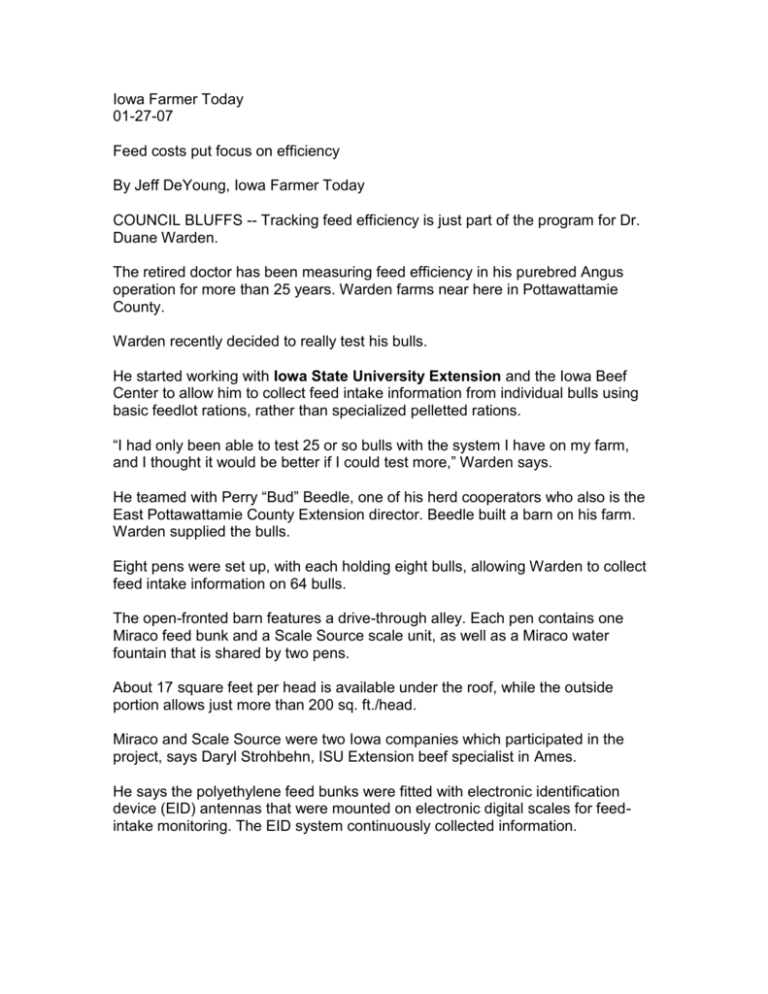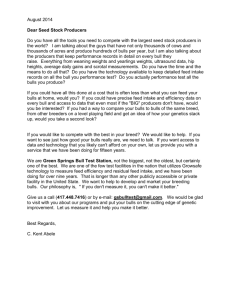Iowa Farmer Today - Iowa State University
advertisement

Iowa Farmer Today 01-27-07 Feed costs put focus on efficiency By Jeff DeYoung, Iowa Farmer Today COUNCIL BLUFFS -- Tracking feed efficiency is just part of the program for Dr. Duane Warden. The retired doctor has been measuring feed efficiency in his purebred Angus operation for more than 25 years. Warden farms near here in Pottawattamie County. Warden recently decided to really test his bulls. He started working with Iowa State University Extension and the Iowa Beef Center to allow him to collect feed intake information from individual bulls using basic feedlot rations, rather than specialized pelletted rations. “I had only been able to test 25 or so bulls with the system I have on my farm, and I thought it would be better if I could test more,” Warden says. He teamed with Perry “Bud” Beedle, one of his herd cooperators who also is the East Pottawattamie County Extension director. Beedle built a barn on his farm. Warden supplied the bulls. Eight pens were set up, with each holding eight bulls, allowing Warden to collect feed intake information on 64 bulls. The open-fronted barn features a drive-through alley. Each pen contains one Miraco feed bunk and a Scale Source scale unit, as well as a Miraco water fountain that is shared by two pens. About 17 square feet per head is available under the roof, while the outside portion allows just more than 200 sq. ft./head. Miraco and Scale Source were two Iowa companies which participated in the project, says Daryl Strohbehn, ISU Extension beef specialist in Ames. He says the polyethylene feed bunks were fitted with electronic identification device (EID) antennas that were mounted on electronic digital scales for feedintake monitoring. The EID system continuously collected information. Only one bull was able to access the feed bunk at a time, allowing the readers to detect EID tags and send that information to the eight-scale indicator, which Strohbehn says coordinates and stores information as it becomes available. Using wireless technology, the scale indicator supplies daily data to a computer which then summarizes daily feed intakes using software developed by the beef center. Warden says the bulls gained more than 3.5 pounds per day on average with a fairly simple ration consisting of corn, silage, ground hay and some wet distillers grains. “I was able to feed those bulls at half the cost of what I was able to do it previously with the same energy level in the feed,” he says. “I was very pleased with that.” Strohbehn says as ethanol co-products are used more frequently in Iowa, producers will have to decide how to best utilize them. Palletting is an option but adds it’s more expensive. “This was a very low-energy ration, much less than what you ordinarily would see in a feedlot, so the gain we saw was very good for that type of ration,” Stroh-behn says. “We wanted to avoid the standard feedlot ration because we didn’t want the bulls getting too fat.” He says the system also helps note the variability in intake, even among a smaller group of cattle. Warden uses this information to better select for feed efficiency in his seedstock operation. “Certainly, it’s a tool we can use, just like the other traits and EPDs (expected progeny differences) we have in our program,” he says. Strohbehn says the system could benefit producers who are serious about strengthening their seedstock programs. “If you are serious about attacking that particular trait area and you are attacking it to make genetic progress in your operation, then it may be worth the expense,” he says. “If you aren’t serious, it’s pretty hard to justify the expense.” Producers should not overlook daughters of bulls who are more feed efficient, Strohbehn adds. “About 70 percent of the energy consumed in the system is for the maintenance of a brood cow, so with these bulls that are more feed efficient, those daughters are becoming more and more important,” he says. “Feed costs are increasing, so it might be something to take a look at.” Warden is testing some heifers on his farm, using a Pinpointer 4000 system he purchased in 1982. The system allows him to measure individual feed consumption. “We’re working on that now and hope to be able to provide that information as well as what we do with the bulls,” he says. “Things seem to be going well this year, so I think we’re on the right track with the program we are using.”







